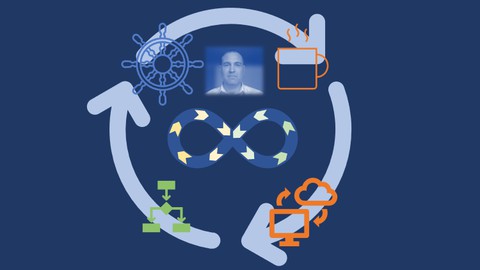
Java Spring Boot Microservices on Kubernetes on AWS Cloud
Java Spring Boot Microservices on Kubernetes on AWS Cloud, available at $19.99, has an average rating of 4, with 98 lectures, based on 2 reviews, and has 61 subscribers.
You will learn about You will learn how to create Microservices with Spring Boot and Java that are run as Docker containers. You will learn how to use Git and GitHub to create Continuous Integration (CI) and delivery (CD) with Docker and Docker Hub. You will learn how to process REST request and use Spring Framework’s processing to serialize, deserialize and process JSON structures. You will learn how to create Docker images and run images as Docker containers as well as deploy images on minikube. You will learn basic commands for Docker and Kubernetes and also to create and use a Postgres database. You will learn how to create Cloud Servers or Instances and deploy applications on Kubernetes. You will also learn how to install Kubernetes. You will learn how to create a web application that retrieves data from the microservices using CSS, HTML, Docker, Tomcat and JavaScript. This course is ideal for individuals who are For anyone that want to learn Microservices with Java Spring Boot. or For anyone that want to learn Continuous Integration (CI) and Delivery (CD) with GitHub and Docker Hub. or For anyone that want to learn Spring data JPA. or For anyone that want to learn the basics of JSON handling and REST services. or For anyone that want to learn the fundamentals of Git, Repositories and GitHub Workflows. or For anyone that want to learn how to create Docker images and deploy on minikube and Kubernetes. or For anyone that want to learn how to create Cloud Servers and install Kubernetes. It is particularly useful for For anyone that want to learn Microservices with Java Spring Boot. or For anyone that want to learn Continuous Integration (CI) and Delivery (CD) with GitHub and Docker Hub. or For anyone that want to learn Spring data JPA. or For anyone that want to learn the basics of JSON handling and REST services. or For anyone that want to learn the fundamentals of Git, Repositories and GitHub Workflows. or For anyone that want to learn how to create Docker images and deploy on minikube and Kubernetes. or For anyone that want to learn how to create Cloud Servers and install Kubernetes.
Enroll now: Java Spring Boot Microservices on Kubernetes on AWS Cloud
Summary
Title: Java Spring Boot Microservices on Kubernetes on AWS Cloud
Price: $19.99
Average Rating: 4
Number of Lectures: 98
Number of Published Lectures: 98
Number of Curriculum Items: 98
Number of Published Curriculum Objects: 98
Original Price: $19.99
Quality Status: approved
Status: Live
What You Will Learn
- You will learn how to create Microservices with Spring Boot and Java that are run as Docker containers.
- You will learn how to use Git and GitHub to create Continuous Integration (CI) and delivery (CD) with Docker and Docker Hub.
- You will learn how to process REST request and use Spring Framework’s processing to serialize, deserialize and process JSON structures.
- You will learn how to create Docker images and run images as Docker containers as well as deploy images on minikube.
- You will learn basic commands for Docker and Kubernetes and also to create and use a Postgres database.
- You will learn how to create Cloud Servers or Instances and deploy applications on Kubernetes. You will also learn how to install Kubernetes.
- You will learn how to create a web application that retrieves data from the microservices using CSS, HTML, Docker, Tomcat and JavaScript.
Who Should Attend
- For anyone that want to learn Microservices with Java Spring Boot.
- For anyone that want to learn Continuous Integration (CI) and Delivery (CD) with GitHub and Docker Hub.
- For anyone that want to learn Spring data JPA.
- For anyone that want to learn the basics of JSON handling and REST services.
- For anyone that want to learn the fundamentals of Git, Repositories and GitHub Workflows.
- For anyone that want to learn how to create Docker images and deploy on minikube and Kubernetes.
- For anyone that want to learn how to create Cloud Servers and install Kubernetes.
Target Audiences
- For anyone that want to learn Microservices with Java Spring Boot.
- For anyone that want to learn Continuous Integration (CI) and Delivery (CD) with GitHub and Docker Hub.
- For anyone that want to learn Spring data JPA.
- For anyone that want to learn the basics of JSON handling and REST services.
- For anyone that want to learn the fundamentals of Git, Repositories and GitHub Workflows.
- For anyone that want to learn how to create Docker images and deploy on minikube and Kubernetes.
- For anyone that want to learn how to create Cloud Servers and install Kubernetes.
You will learn how to create Java Spring Boot applications that are managed and run as Microservices. You will learn how to use Git, GitHub, Docker and Docker Hub to setup Continuous Integration and Delivery (CI/CD). You will also learn how to deploy applications on both minikube and Kubernetes installed on Cloud servers. You will also learn how to process REST request and use Spring Framework to serialize, deserialize and process JSON structures. You will learn how to use Docker to create and run images which you will then deploy on Kubernetes. You will learn how to create AWS servers (instances) in the Cloud and install Kubernetes to create your own cluster.
In bullets:
-
REST applications in Java Spring Boot with Postman as a REST client
-
Spring Data JPA (Java Persistent API)
-
Microservices and communication between services in Spring and in Docker containers
-
Docker images, containers and registries
-
Git repositories and configuration of workflows for Continuous Integration (CI) and Delivery (CD) with GitHub and Docker Hub
-
AWS EC2 instances (Servers) in the Cloud
-
Kubernetes on AWS Cloud servers and application deployment
-
Introduces different parts that could be used to find a specific part to dig deeper into as for example Spring, GitHub CI/CD, Docker or Kubernetes.
-
You will also create a web application that connects and retrieves data from the microservices. This will be deployed as a separate application using CSS, HTML, Docker, Tomcat and JavaScript to call the microservices.
What the organizations say about their own products:
Java –
“The world’s most popular modern development platform, Java SE is the programming language of choice for enterprise applications.” (java – Oracle)
Spring Boot and REST services –
“Spring’s focus on speed, simplicity, and productivity has made it the world’s most popular Java framework”(why-spring – Spring)
“REST has quickly become the de-facto standard for building web services on the web because they’re easy to build and easy to consume” (rest – Spring)
Microservices with JPA –
“Microservice architectures are the ‘new normal’. Building small, self-contained, ready to run applications can bring great flexibility and added resilience to your code.” (microservices – Spring)
CI/CD with GitHub & Git –
“Automate, customize, and execute your software development workflows right in your repository with GitHub Actions. You can discover, create, and share actions to perform any job you’d like, including CI/CD, and combine actions in a completely customized workflow.”(actions – GitHub)
Docker and minikube
“The Industry-Leading Container Runtime
Docker Engine powers millions of applications worldwide, providing a standardized packaging format for diverse applications.”(container-runtime – Docker)
“minikube quickly sets up a local Kubernetes cluster on macOS, Linux, and Windows”(minikube)
Kubernetes on AWS Cloud Services
“Kubernetes, also known as K8s, is an open-source system for automating deployment, scaling, and management of containerized applications.”(kubernetes)
“Designed on the same principles that allow Google to run billions of containers a week, Kubernetes can scale without increasing your operations team.”(kubernetes)
“Cloud computing is the on-demand delivery of IT resources over the Internet with pay-as-you-go pricing. Instead of buying, owning, and maintaining physical data centers and servers, you can access technology services, such as computing power, storage, and databases, on an as-needed basis from a cloud provider like Amazon Web Services (AWS).”(what-is-cloud-computing – Amazon)
Course Curriculum
Chapter 1: Introduction
Lecture 1: Introduction
Lecture 2: Setup the environment
Chapter 2: Rest and Spring Annotation
Lecture 1: Overview: Basics in REST and Spring annotation
Lecture 2: Logging, Autowire, Environment, Configuration file and PathVariable
Lecture 3: RequestBody, POST Mapping, JSON HTTP Body
Lecture 4: Put and Delete mapping, RequestBody, PathVariable, JSON
Lecture 5: PostConstruct, Environment, Property file, JSON Response
Lecture 6: Exception Handler
Chapter 3: Basics in Spring JPA
Lecture 1: Overview JPA: Entity, Table, Column, Id, Repository, H2 Database, Configuration
Lecture 2: Entity, Table, Column, Id, GeneratedValue, JpaRepository, findMethod
Lecture 3: Save to Database, H2 configuration, JSON Body, Repository, RestController
Lecture 4: Read from Database, Repository findAll, getMethod Names and JSON Response
Lecture 5: Query builder mechanism, Key words, Return type, Query creation, Find by Header
Lecture 6: Query builder mechanism, NoteDocument Repository, Find method, And Key word
Lecture 7: Spring Test and Junit5 tests
Chapter 4: Spring JSON Processing and JSON Format
Lecture 1: Overview Basics in JSON Processing
Lecture 2: Jackson Object Mapper, Serialize Object, Post JSON, RequestBody, String Object
Lecture 3: Jackson Object Mapper, Deserialize JSON, RequestBody
Lecture 4: Jackson FasterXml, Parse JSON Array and Object, Format conversion
Lecture 5: Document & NoteJsonMapper, ObjectMapper Array, Annotation ‘produces’
Chapter 5: Spring Microservices
Lecture 1: Overview Microservices
Lecture 2: Spring Project, Document Microservice, Repository, Entity, Table, Column, Id
Lecture 3: Document Controller, Store Document, Repository Save, JSON Body
Lecture 4: Document Controller, Retrieve Document, Repository Read, JSON Response
Lecture 5: NoteDocument Repository, Entity, Table, Column, Id, Reference Binder
Lecture 6: Store Note and Document Reference, Repository Save
Lecture 7: Reference binder JSON Syntax, Store Note Document Reference
Lecture 8: Retrieve Note and References, Repository Read and Find Method, Reference Binder
Lecture 9: Reactor Client, Server Port, Store Note and References
Lecture 10: Retrieve Note and Document, Reactor client, Call Document Microservice
Lecture 11: Document JSON syntax, ObjectMapper, Note Document Binder Response
Lecture 12: Tests for the Document, NoteDocument and Repository Classes
Chapter 6: Docker
Lecture 1: Overview Basics in Docker
Lecture 2: Dockerfile, Docker Hub, Exercises application
Lecture 3: Build Images, Filter images, Exercises application
Lecture 4: Run Image as Container, List Containers, Verify the Application with a Client
Lecture 5: Run Detached Containers, View Container Logs
Lecture 6: Run Container in Interactive Mode, Interactive Shell on a Running Container
Lecture 7: Docker Network, Communicating Containers, Stop and Prune Containers
Chapter 7: Kubernetes Minikube
Lecture 1: Overview Basics in Kubernetes Minikube
Lecture 2: Minikube Start, Dashboard, Delete Resources, Addons
Lecture 3: Minikube Kubectl, Cluster-info, Get & Describe Resources, Image ls & rm, Help
Lecture 4: Define a Service & Deployment
Lecture 5: Install Kubectl, Kubectl & minikube Versions
Lecture 6: Create Deployment, Get & Describe Service & Pod
Lecture 7: Minikube Tunnel, Verify Application, Kubectl Logs & Interactive Command
Lecture 8: Deployment Definition with Docker Hub, minikube Get & Delete Resources
Lecture 9: Docker Registry Secret, Create Deployment, Verify Application
Chapter 8: Git and GitHub Repository
Lecture 1: Git & GitHub Overview, Git Configuration files
Lecture 2: Git & GitHub Create Repository, Git Ignore file, Commit to Local Repository
Lecture 3: Git Push to Remote Repository, GitHub Repository
Lecture 4: Git Fetch, Pull, Diff
Lecture 5: Git & GitHub Document Service
Lecture 6: Git Log, Branch Local & Remote, Checkout
Lecture 7: Git Restore, Delete Local & Remote Branch
Chapter 9: Continuous Integration and Delivery (CI/CD), GitHub Actions, Docker Hub
Lecture 1: Overview Basics in CI/CD
Lecture 2: Continuous Integration & Delivery, Create a Workflow, Workflow syntax
Lecture 3: Workflow Triggers, Job Steps, Build with Maven
Lecture 4: Docker Hub Action, Login, Build and Push
Lecture 5: GitHub Variables & Secrets, Docker Hub UserName & AccessToken
Lecture 6: Manual Trigger, Run Workflow, Push Image to Docker Hub
Lecture 7: Context Variable, Branch Name in Build, Push Image to Docker Hub
Lecture 8: IF conditional, Release Branch, Spring Profiles and Dockerfiles in Workflows
Chapter 10: Cloud servers (AWS)
Lecture 1: AWS Account, Create EC2 Instance, Key Pairs, Firewall Ports and IPs
Lecture 2: NGINX, Create EC2 Instance, Access Test to NGINX
Chapter 11: Kubernetes on Cloud Servers (AWS), Continuous Deployment
Lecture 1: Overview Cloud Servers and Kubernetes
Lecture 2: Install Docker (Worker Node)
Lecture 3: Install Docker (Control Node)
Lecture 4: Install Kubernetes Cluster (Control Node)
Lecture 5: Kubernetes Cluster Private Keys Configuration
Lecture 6: Git & GitHub Deployment Repository & AWS Kubernetes Deployment Definition
Lecture 7: GitHub Access Token, GitHub Client (GH) Install, Login
Lecture 8: GH Repo Clone, Kubernetes Secret, Deployment Definition with DockerHub
Lecture 9: Deploy Application, Service Port in the AWS Firewall, Application Access
Lecture 10: Continuous Deployment, Rollout Restart & Status, Build Workflow
Chapter 12: Feature, Branches and CI/CD – Document Service (Development & minikube)
Lecture 1: Overview Lecture 13 – 15
Lecture 2: Create Branch, Checkout Branch, View Branch in Eclipse
Lecture 3: Implementation of Update & Delete
Lecture 4: Git Commit, Create Remote Feature Branch, Push
Lecture 5: Verify that the application works with Postman
Lecture 6: Workflow File Build on Pull Request, Kubernetes Deployment File
Lecture 7: Pull Request, Release Branch, Deliver Test Image
Lecture 8: Deploy Service to minikube, Verify with Postman, Delete Branch
Chapter 13: CI/CD of the Exercises Application – New version (Development & minikube)
Lecture 1: Verify the Exercises Application with Postman (Development)
Lecture 2: Workflow Build & Release Test
Lecture 3: Create Release Branch, Deliver Image, Deploy to minikube
Lecture 4: Verify the Exercises Application with Postman (minikube)
Instructors
-
Klas Bandholtz
System Analyst and Developer
Rating Distribution
- 1 stars: 0 votes
- 2 stars: 0 votes
- 3 stars: 1 votes
- 4 stars: 1 votes
- 5 stars: 0 votes
Frequently Asked Questions
How long do I have access to the course materials?
You can view and review the lecture materials indefinitely, like an on-demand channel.
Can I take my courses with me wherever I go?
Definitely! If you have an internet connection, courses on Udemy are available on any device at any time. If you don’t have an internet connection, some instructors also let their students download course lectures. That’s up to the instructor though, so make sure you get on their good side!
You may also like
- Top 10 Agile Methodologies Courses to Learn in December 2024
- Top 10 Project Management Courses to Learn in December 2024
- Top 10 Leadership Skills Courses to Learn in December 2024
- Top 10 Public Speaking Courses to Learn in December 2024
- Top 10 Affiliate Marketing Courses to Learn in December 2024
- Top 10 Email Marketing Courses to Learn in December 2024
- Top 10 Social Media Management Courses to Learn in December 2024
- Top 10 SEO Optimization Courses to Learn in December 2024
- Top 10 Content Creation Courses to Learn in December 2024
- Top 10 Game Development Courses to Learn in December 2024
- Top 10 Software Testing Courses to Learn in December 2024
- Top 10 Big Data Courses to Learn in December 2024
- Top 10 Internet Of Things Courses to Learn in December 2024
- Top 10 Quantum Computing Courses to Learn in December 2024
- Top 10 Cloud Computing Courses to Learn in December 2024
- Top 10 3d Modeling Courses to Learn in December 2024
- Top 10 Mobile App Development Courses to Learn in December 2024
- Top 10 Graphic Design Courses to Learn in December 2024
- Top 10 Videography Courses to Learn in December 2024
- Top 10 Photography Courses to Learn in December 2024






















